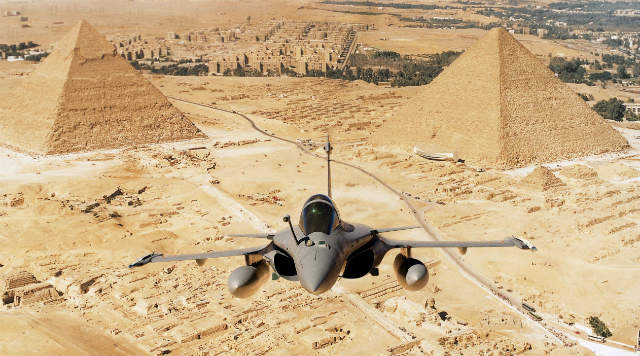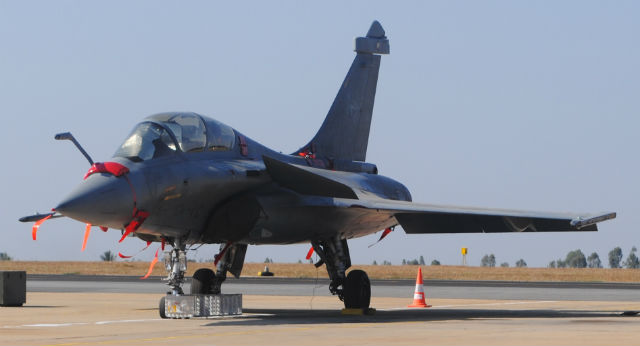Dassault Aviation's flagship fighter – the multi-role, twin-engined Rafale – has had a successful 2015 to date, with what had once appeared to be a dire export outlook re-energised with a number of firm contract orders.
The aircraft had previously only been acquired by its domestic air force and navy, and although promises and selections for the type had been made by a number of potential export customers, Dassault was struggling to achieve firm deals for Rafale.
All of this has changed, however, as a February deal from Egypt saw its air force put the stamp on a deal for 24 Rafales. This success was followed soon after by Qatar, which also selected to purchase 24 of the type in April. A contract signature was made in Doha in early May.
France has been fully behind the aircraft. The nation's air force operates 48 two-seater B-model Rafales, and 45 single-seater C models, Flightglobal’s MiliCAS fleet database shows. The navy has 35 M-variant maritime single-seaters.
Following introduction with the navy and air force between 2004 and 2006 and replacing seven types of aircraft, Rafales have been involved in a number of operations, most recently in counter-insurgency operations as a part of the coalition effort against Islamic State militants in Iraq, and against terrorists in Mali under France’s Operation Serval.
It also took part in the operations in Afghanistan and Libya, in 2007-2012 and 2011 respectively, and has deployed to eastern Europe in support of NATO’s Baltic Air Policing mission that looks to defend the states of Estonia, Latvia and Lithuania against the threat from Russia.
Yet despite operational success with France, and an involvement in fighter campaigns and competitions the world over, Dassault was struggling to receive orders for the type until Egypt set the ball rolling in February.

Dassault Aviation
Egypt already operates three Dassault strike types, namely 45 Alpha Jets, 82 Mirage 5s and 15 Mirage 2000s.
“This decision is a continuation of our co-operation that dates back to the 1970s, and has seen the Mirage 5, the Alpha Jet and the Mirage 2000 fly in the colours of Egypt. The Rafale meets the needs of countries that, like Egypt, demand a sovereign air force of the best level,” Dassault said on receiving the contract from Cairo.
Qatar is also a seasoned Dassault customer, having previously operated the Mirage F1 and still having 13 Mirage 2000-5s and six Alpha Jets in its inventory.
"This new success for the French team demonstrates the Rafale's operational qualities and confirms the confidence that countries which are already users of the Mirage 2000 have in our company,” Eric Trappier, chief executive of Dassault, said at the point of selection.
French President Francois Hollande said at the contract signing in Doha that despite the initial order only being for 24 of the type, “there may later be an option for further acquisitions of this aircraft”.
He added that the reliability and credibility of Rafale has led to Qatar and Egypt selecting the aircraft, while it will be “India tomorrow” and other countries in the future.
Now that these two acquisitions are underway, the focus is now centred on the potential sale of the type to India.
New Delhi has shown interest in the Rafale for some time, but despite having selected the aircraft to meet a $20 billion, 126-unit requirement three years ago, it is now set to only place a 36-strong initial order, bypassing the original large acquisition programme.
In April, Indian Prime Minister Narendra Modi announced during a visit to France that New Delhi had requested 36 Rafales to fulfil what was originally its medium multi-role combat aircraft (MMRCA) requirement to replace the Mikoyan MiG-21, although a contract order is still pending.
Original requirements for MMRCA would have seen indigenous manufacturer Hindustan Aeronautics (HAL) develop 108 of the 126-unit order after the first 18 were delivered from France, but doubts were believed to have been cast over Dassault’s trust in HAL to be able to deliver the aircraft to a reliable standard.
Indian defence minister Manohar Parrikar has since declared that a 126-unit order would be “economically unviable”, the Indian press reported in May, undermining the previous government that was said to have “hammered” the programme so that it would never have been finalised.
Parrikar noted that a committee has been set up to outline the terms of the contract, and this would be completed in the next two to three months.

Aaron Chong/Flightglobal
Meanwhile, the next target market for Rafale remains to be seen. The total number of exported Rafales would total 84 if the Indian deal comes through, but is down based on original projections that included an additional 90 aircraft for India. Therefore, further sales are going to have to be made to justify keeping the production line going past the 84.
One lost competition was a tender in Brazil that was swooped up in October 2014 by another European design, in the form of the Saab Gripen multirole fighter. This contract will see the Swedish airframer and its local production partner Embraer provide 28 Gripen NGs plus eight two-seat F-model examples under Brasilia’s F-X2 programme.
When the Gripen was selected in 2013, Dassault publicly announced its disappointment in the selection, claiming that the use of US-built parts in the Saab design would prove problematic.
“We regret that the choice has gone in favour of the Gripen, an aircraft provided with many items of equipment of third party origin, especially the USA, and that does not belong to the same category as the Rafale,” Dassault said in December 2013. “The Gripen is a lighter, single-engine aircraft that does not match the Rafale in terms of performance and therefore does not carry the same price tag.
“This financial rationale fails to take into account either the Rafale’s cost-effectiveness or the level of technology offered,” it claimed. The company had also lost out to the Gripen in a Swiss competition, although a public referendum ultimately derailed the Saab victory.
A competition in Malaysia for its multirole combat aircraft (MRCA) competition, for which the Rafale is a candidate, could still prove fruitful for the French manufacturer. The Rafale is expected to compete against the Boeing F/A-18 E/F Super Hornet, the Eurofighter Typhoon and the Gripen for the tender, which will replace Malaysia’s 10 obsolete RAC MiG-29s.
Canada has selected the Lockheed Martin F-35 Lightning II, but it is doubtful whether the current requirement for 65 of the type will be made.
Ottawa appears to be keeping an open mind in its selection of aircraft to replace its 101-strong fleet of Boeing CF-18s – including training assets – and rivals to the type are being pitched by manufacturers in the hope that an alternative will be selected.
In 2014, the Canadian government compared four aircraft – the F-35, Super Hornet, Rafale and Typhoon – in its Evaluation of Options for the Replacement of the CF-18 Fighter Fleet report, which concluded that all types were low-risk replacements when assessed on their ability to carry out six mission sets that would be required to defend Canadian airspace. These included responding to international events such as the Olympics, against a terrorist attack, for peace enforcement, humanitarian disaster relief and state-on-state war fighting.
All aircraft were deemed low-risk offerings for performing each mission up to 2030 and beyond, except in fighting another peer nation. In that category, all the aircraft were deemed a higher risk platform beyond 2030 and none distinguished itself, but this mission was dismissed as highly unlikely by the government.
A radar upgrade for the Typhoon, meanwhile, has added market worth to the Eurofighter, which could challenge further exports of the Rafale.
Eurofighter partner nations Germany, Italy, Spain and the UK agreed last November to complete the development and integration of an active electronically scanned array (AESA) radar for the type.
The development will lead to the $1.2 billion completion of work on the Euroradar consortium’s Captor E-Scan, and is expected to provide more export potential for the Typhoon. The UK is also advancing a Selex ES-led development of a nation-specific AESA system for potential integration with some of its Typhoons, having signed a £72 million ($110 million) deal for the work earlier in 2014.
“The signing of this contract is a massive boost to all of us and is a pivotal moment,” Eurofighter consortium chief executive Alberto Gutierrez said.
While the Rafale already operates an AESA radar in the form of the Thales RBE2 – which Thales claims is the first European combat radar with the electronic scanning capability – the export boost that this potentially offers Typhoon will make it far more competitive, and is pivotal at a time when both types are at similar levels of export success. Securing India's order will take Rafale to 84 aircraft sold to international customers, while Typhoon exports stand at 99 aircraft for Austria, Oman and Saudi Arabia.
In addition to the radar, Thales also supplies the Spectra electronic warfare system, optronics, communication and navigation systems, an identification suite, avionics and power-generation systems for the Rafale. This amounts to approximately 25% of the total value of the aircraft, the electronics provider says.
On the developmental side, in early 2014 the French government approved the $1 billion upgrade of the Rafale to a new F3R standard that would allow for new weapons and equipment integration.
This includes the integration of MBDA’s Meteor beyond visual-range air-to-air missile and the Sagem AASM "Hammer" air-to-surface guided munition, earlier versions of which were used during France’s operations in Libya and throughout Operation Serval.
Under this development effort, in April a French team successfully tested Meteor against an airborne target from a Rafale.

DGA
Supported by personnel from France’s DGA defence procurement agency, Dassault and MBDA, the 28 April firing was performed from a Rafale B operating from the Cazaux flight test centre. The DGA expects production rounds for aircraft flown by the French air force and navy to be delivered by 2018.
The newest iteration of Thales' PDL-NG laser designation pod will also be added to Rafale, which is subject to a separate development contract awarded by the DGA. Risk-reduction activities on the pod were conducted throughout 2013, and Thales says it aims to begin series production in 2018 in line with the weapons upgrades; the PDL-NG is designed to be integrated with both the Rafale and Dassault's legacy Mirage 2000D.
Separately, a “heavily armed” Rafale, integrating the AASM, Meteor and MBDA Mica air-to-air missile, as well as auxiliary fuel tanks, underwent testing in 2014.
During the preliminary evaluation sorties, the aircraft carried six "Hammers", four medium- and long-range Micas and a pair of Meteors on 12 of its 14 external hard points. It was also equipped with three 2,000 litre external fuel tanks.
The self-funded effort was conducted in collaboration with the DGA, and will "eventually lead to a complete clearance of the flight envelope", according to Dassault.
The company claims that the work to enhance Rafale’s capabilities demonstrates the type’s versatility, while arguing that a pair of the aircraft "represent the same potential as six Mirage 2000-class aircraft".
The C and M variants of Rafale will both be on display by Dassault during the Paris air show, while the French military will show two Rafales as well as a Mirage 2000.
Check out the latest news, analysis and opinion from this year's Paris air show
Source: Flight International



















